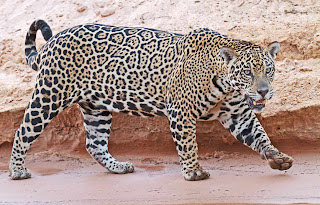One morning I ran into a collared jaguar panting with saliva dripping from the mouth. It appeared stressed by the tracking collar. These collars carry telemetry devices to track the animal movements; some are able to monitor physiological and environmental parameters too. While watching the jaguar, the guide told me that 3 collared jaguars were recently found dead. The rumor was that the lost of these endangered cats was caused for having the collars to tight.
There appears to be various groups involved in collaring jaguars in the Pantanal; but it was not clear if the responsible culprits were private individuals, environmental private groups or government agencies. A wildlife management friend confirmed that it is critical how these collars are fitted to the animals, if too tight, they may cause problems. And these are not just limited to physiological burdens but may also induce behavioral changes.
The use of tracking collars has become widespread since the early 1990's to study animal migration patterns, territorial boundaries, etc. As the collars became more sophisticated, they are capable of recording physiological as well as environmental parameters. The information is collected in the collar or transmitted by radio signals to cell phones or via satellites. Originally the tracking devices were equipped only with a VHF beacon and the trackers have to follow the collared subjects in the field with an antenna to determine their whereabouts. Older models also used to collect the information in the collar itself and to retrieve the data, the animal has to be recaptured again. Newer collars can be programmed to drop-off from the animal and the data analyzed. But the trend is towards collars that transmit the data and that can be reprogrammed by telemetry.
Does the fitting of tracking collars have an impact in the involuntary user? There was a study conducted of Florida Everglades between 1978-79; of the 65 deaths recorded, 41 were radio collared. Of the collared panthers that died, it was determined that 33% died in fights with other panthers (is the collared jaguar impaired by the collar during the fight?). Another factor affecting the mortality of animals is during their capture to be fitted with collars, usually with tranquilizing dart guns. If the anesthetic dose is not properly calculated, it may result in the animal death. Also the handling of the anesthetized animal while being collared, measured, weighted, and biological sampled, may result in additional injuries.
Does the practice of using collars for wildlife management worth the loss of animals? Are those involved in these practices professionally trained to safely conduct such endeavors? Are the wildlife populations benefiting from this practice? What is the data used for? Are there funds available to improve of the species habitat based in the data obtained if analyzed? I have not formed an opinion as to benefits of this practice. But is surely annoys me when I encounter collared animals in the wild. Will there be any wilderness left?









4 comments:
Amazing animals!
Have a great weekend.
Oh Jose, I think this is the saddest post I have ever seen!! Another case of human intervention causing havoc and deaths. You are right, DO we love these animals too much and think we are helping them while all the time doing them harm? Is it just a few unknowing and inexperienced souls doing what they THINK is right?
Humans are such disgusting creatures in so many ways because they were given the power to have a brain and they use it to interfere in nature and things they really know nothing about.
Time and time again it has been proved that nature knows best and if left alone, it will take care of itself. Now all those stunningly beautiful animals just because we “care” about them. How sad that things in this world have come to this.
Thank you for a wonderful, if sad, post Jose and sharing the plight of these creatures with us.
Excelente serie de retratos José.Es muy interesante el tema que se plantea en tu blog acerca de la intervención del hombre y las consecuencias buenas y malas que eeso tiene.
Esperemos que los problemas puedan superarse pronto para que las poblaciones de estos depredadores puedan prosperar
abrazo
Mariano
siempre me pregunte si los collares en los animales salvajes no interferian en su vida normal??, y siempre me causaron una impresion negativa, y ahora me lo estas confirmando. Las fotos como siempre, un maestro!!!!, un abrazo
Post a Comment